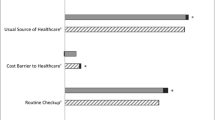Summary
Objective
Population-based rates for the delivery of adult vaccinations or screenings are typically tracked as individual services. The current approach is useful in monitoring progress toward national health goals but does not yield information regarding how many U.S. adults receive a combination of preventive services routinely recommended based on a person’s age and gender. A composite measure is important for policymaking, for developing public health interventions, and for monitoring the quality of clinical care. During the period under study, influenza vaccination was newly recommended (2000) to be routinely delivered to adults in this age range. The objective of the study was to compare the delivery of routine clinical preventive services to U.S. adults aged 50–64 years between 1997 and 2004 using a composite measure that includes cancer screenings and vaccinations.
Design
Data were collected via telephone surveys in 1997, 2002, and 2004 as part of the Behavioral Risk Factor Surveillance System.
Participants
The participants were randomly selected adults aged 50–64 years in the 50 states and the District of Columbia in the selected years. Sample sizes ranged from 24,917 to 77,244.
Measurements and Main Results
The composite measure includes screening for colorectal cancer, cervical cancer, breast cancer, and vaccination against influenza (2002 and 2004 only). The composite measure quantifies the percentage of adults who are up-to-date with the complete set according to recommended schedules. With the inclusion of newly recommended influenza vaccination, the percentage of men and women aged 50–64 who were up-to-date on all selected measures in 2004 was 23.4% and 23.0%, respectively, compared with 37.6% and 30.5% in 1997. Without including influenza vaccination, the percentage of up-to-date adults aged 50–64 would have risen in 2004 to 50.5% (men) and to 44.7% (women). For both sexes, results varied by education, race/ethnicity, marriage status, insurance status, health status, and state.
Conclusion
In 2004, the percentage of adults aged 50–64 years receiving routinely recommended cancer screenings and influenza vaccination was low with fewer than 1 in 4 being up to date.
Similar content being viewed by others
References
Centers for Disease Control and Prevention. Prevention and control of influenza. Morb Mort Wkly Rep Recomm Rep. 2000;49(RR03):1–38.
Behavioral Risk Factor Surveillance System. Prevalence Data: Nationwide (States, DC, and Territories)—2004 Health Care Access/Coverage. Available at: http://apps.nccd.cdc.gov/brfss/age.asp?cat=HC&yr=2004&qkey=868&state=US. Accessed October 29, 2007.
U.S. Department of Health and Human Services. Healthy People 2010: Understanding and Improving Health. 2Washington, DC: U.S. Government Printing Office; 2000.
U.S. Preventive Services Task Force. Clinical Preventive Services for Normal-Risk Adults Recommended by the U.S. Preventive Services Task Force. Put Prevention into Practice, January 2004. Rockville, MD: Agency for Healthcare Research and Quality; 2004Available at: http://www.ahrq.gov/clinic/pocketgd07/. Accessed October 29, 2007.
Shenson D, Bolen J, Adams M, Seeff L, Blackman D. Are older adults up-to-date with cancer screening and vaccinations? Prev Chronic Dis [serial online] 2005 Jul [date cited]. Available from: URL: http://www.cdc.gov/pcd/issues/2005/jul/05_0021.htm. Accessed October 29, 2007.
Behavioral Risk Factor Surveillance System Operational and Users Guide Version 3.0 March 2005. Available at: http://www.cdc.gov/brfss/pdf/userguide.pdf. Accessed October 29, 2007.
Bolen JC, Rhodes L, Powell-Griner EE, Bland SD, Holtzman D. State-specific prevalence of selected health behaviors, by race and ethnicity—Behavioral Risk Factor Surveillance System, 1997. MMWR CDC Surveill Summ. 2000;49(SS-2):1–60.
Behavioral Risk Factor Surveillance System Summary Data Quality Report; 2002. Available at: http://www.cdc.gov/brfss/technical_infodata/pdf/2002SummaryDataQualityReport.pdf. Accessed October 29, 2007.
Behavioral Risk Factor Surveillance System Summary Data Quality Report; 2004. Available at: http://ftp.cdc.gov/pub/Data/Brfss/2004SummaryDataQualityReport.pdf. Accessed October 29, 2007.
Centers for Disease Control and Prevention. State-specific trends in self-reported blood pressure screening and high blood pressure—United States, 1991–1999. Morb Mortal Wkly Rep. 2002;51:456−60.
Pascual FB, McGinley EL, Zanardi L, Cortese MM, Murphy TV. Tetanus surveillance—United States, 1998–2000. Morb Mortal Wkly Rep. 2003;52(SS03):1–8.
Shenson D, Bolen J, Adams M. Receipt of preventive services by elders based on composite measures, 1997–2004. Am J Prev Med. 2007;32(1):11–8.
Nelson DE, Bland S, Powell-Griner E, et al. State trends in health risk factors and receipt of clinical preventive services among US adults during the 1990s. JAMA. 2002;287:2659–67.
Breen N, Wagener DK, Brown ML, Davis WW, Ballard-Barbash R. Progress in cancer screening over a decade: results of cancer screening from the 1987, 1992, and 1998 National Health Interview Surveys. J Natl Cancer Inst. 2001;93:1704–13.
McGlynn EA, Asch SM, Adams J, et al. The quality of health care delivered to adults in the United States. N Engl J Med. 2003;348(26):2635–45.
Shenson D. Putting prevention in its place: the shift from clinic to community. Health Aff (Millwood). 2006;25(4):1012–15 (Jul–Aug).
Davis RL, Lieu TA, Mell LK, et al. Impact of the change in polio vaccination schedule on immunization coverage rates: a study in two large health maintenance organizations. Pediatrics. 2001;107(4):671–6.
Task Force on Community Preventive Services. Introducing the guide to community preventive services: methods, first recommendations and expert testimony. Am J Prev Med. 2000;18(1S):35–43.
Yarnall KS, Pollak KI, Østbye T, Krause KM, Michener JL. Primary care: is there enough time for prevention? Am J Public Health. 2003;93:635–1.
Sudman SN, Bradburn NM. Effects of time and memory on response in surveys. J Am Stat Assoc. 1973;68:805–5.
Newell SA, Girgis A, Sanson-Fisher RW, Savolainen NJ. The accuracy of self-reported health behaviors and risk factors relating to cancer and cardiovascular disease in the general population: a critical review. Am J Prev Med. 1999;17:211–29.
Thornberry OT, Massey JT. Trends in the United States telephone coverage across time and subgroup. In: Groves RM, Biemer PP, Lyberg L, Massey JT, Nichols WL, eds. Telephone Survey Methodology. New York, NY: Wiley; 1988:25–49.
Centers for Disease Control and Prevention. Trends in screening for colorectal cancer, US 1997 and 1999. Morb Mortal Wkly Rep. 2001;50(9):162–6.
Acknowledgment
The authors thank Lynda Anderson, Ph.D., Michel Alderman, M.D., and David Nelson, M.D., M.P.H., for their review of earlier drafts of this article. Funding for this research was provided by the CDC.
Conflict of Interest
The findings and conclusions in this article are those of the authors and do not necessarily represent the views of the CDC.
Author information
Authors and Affiliations
Corresponding author
Electronic supplementary material
Below is the link to the electronic supplementary material.
11606_2008_555_MOESM1_ESM.doc
Online Appendix Table 1 Prevalence of being up-to-date (UTD)* for men age 50–64 years, by state, Behavioral Risk Factor Surveillance System (BRFSS) 1997, 2002, 2004† (DOC 202 kb)
11606_2008_555_MOESM2_ESM.doc
Online Appendix Table 2 Prevalence of being up-to-date (UTD)* for women age 50–64 years, by state, Behavioral Risk Factor Surveillance System (BRFSS) 1997, 2002, 2004† (DOC 134 kb)
Rights and permissions
About this article
Cite this article
Shenson, D., Adams, M. & Bolen, J. Delivery of Preventive Services to Adults Aged 50–64: Monitoring Performance Using a Composite Measure, 1997–2004. J GEN INTERN MED 23, 733–740 (2008). https://doi.org/10.1007/s11606-008-0555-7
Received:
Revised:
Accepted:
Published:
Issue Date:
DOI: https://doi.org/10.1007/s11606-008-0555-7




